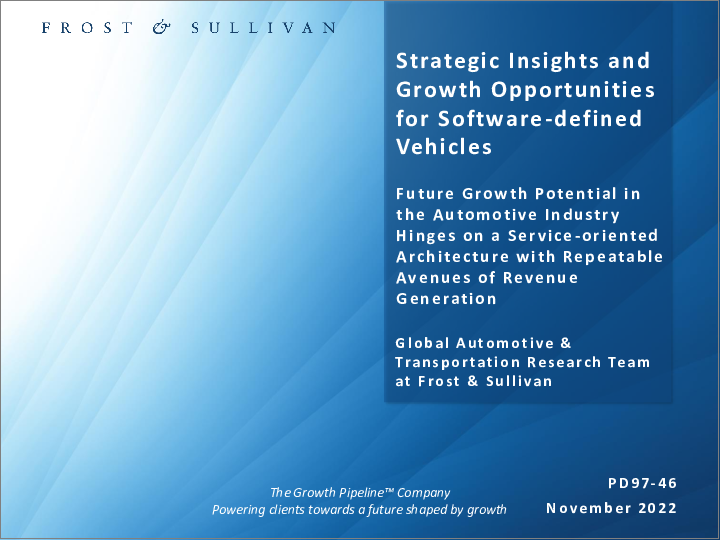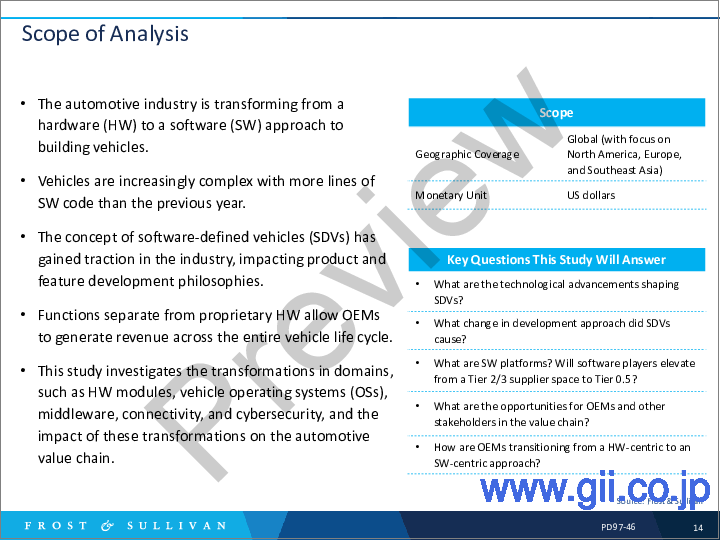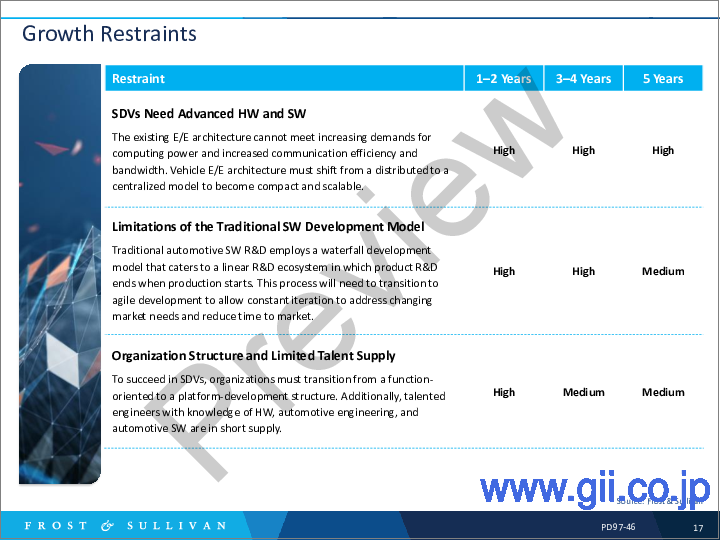|
|
市場調査レポート
商品コード
1165556
SDV(Software-Defined Vehicle)の世界市場:戦略的洞察と成長機会Strategic Insights and Growth Opportunities for Software-defined Vehicles |
||||||
| SDV(Software-Defined Vehicle)の世界市場:戦略的洞察と成長機会 |
|
出版日: 2022年11月02日
発行: Frost & Sullivan
ページ情報: 英文 105 Pages
納期: 即日から翌営業日
|
- 全表示
- 概要
- 目次
電動化、自律走行、シェアードモビリティ、コネクティビティなどの技術の融合により、OEMは従来のハードポイントで定義されたアーキテクチャからソフトウェア指向のアーキテクチャへの移行を進めています。
当レポートでは、世界のSDV(Software-Defined Vehicle)市場のついて調査分析し、成長促進要因、成長抑制要因、市場収益予測など、市場に影響を与える主要動向の詳細な分析を提供しています。
目次
戦略的必須事項
- 成長がますます困難になっているのはなぜですか?
- The Strategic Imperative 8(TM)
- SDV(Software-Defined Vehicle)業界に対する上位3つの戦略的必須事項の影響
- 成長機会がGrowth Pipeline Engine(TM)を促進
成長環境
- 分析範囲
- SDVとは?
- SDVの特徴
- SDVにつながる主な動向
- 成長促進要因
- 成長抑制要因
- SDVのライフサイクル
- SDVの構成要素
- SDVへの取り組み
ハードウェアモジュール
- E/Eアーキテクチャの進化
- さまざまなE/Eアーキテクチャの特徴
- E/Eアーキテクチャの進化への道
- ハードウェアとソフトウェアの分離を可能にする集中型アーキテクチャ
- HWモジュールにおけるOEMアクティビティの選択
- ケーススタディ:Snapdragonデジタルシャーシ
- ケーススタディ:Teslaパーシャルゾーンアーキテクチャからフルゾーンアーキテクチャへ
- ケーススタディ:STLA BRAINプラットフォーム
車両オペレーティングシステム(OS)
- 主な動向
- SDVのOS移行
- OS概要
- 車載OSの高レベル構造
- 車載OS要件
- 車両OS開発戦略
- OSバリューチェーン
- OEM活動
- OSベンチマーク
- ケーススタディ:Androidの台頭
- ケーススタディ:Android Automotive OS
- ケーススタディ:VW.OS
- ケーススタディ:MB.OS
- ケーススタディ:Blackberry車載OSコンポーネント
ミドルウェア
- 自動車ミドルウェア
- 自動車ミドルウェアプロトコルの比較
- ケーススタディ:自動運転のミドルウェア要件
- ケーススタディ:ZFミドルウェア
コネクティビティ
- 車両コネクティビティの進化
- 地域別の組み込み接続
- 自動クラウド戦略の重要性
- OEMのクラウド戦略のスナップショット
- オンデマンド機能を許可するOTAアップデート
- クラウドネットワーキングとサービスの主要なクラウドプレーヤー
- クラウドネットワーキングにおけるOEMパートナーシップと活動
- ケーススタディ:Amazonのコネクテッドカーエコシステム
サイバーセキュリティ
- 自動車のサイバーセキュリティ:考えられる攻撃のシナリオと影響
- SDVにおけるサイバー攻撃のシナリオ
- 階層化されたサイバーセキュリティアプローチ
- 車両SWとシステムのサイバーリスク評価
- 自動車サイバーセキュリティバリューバリューチェーン
- 自動車におけるさまざまなタイプのサイバーセキュリティソリューション
- SDVにおけるサイバーセキュリティの脅威の概要
- OEMサイバーセキュリティパートナーシップと戦略の概要
- 自動車サイバーセキュリティ企業:比較分析
- 半導体およびチップメーカー:比較分析
- 自動車Tier Iサプライヤー:比較分析
- ケーススタディ:Boschのサイバーセキュリティ
- ケーススタディ:Cybellumデジタルツイン(TM)プラットフォーム
- ケーススタディ:Harman CybersecurityとWP.29コンプライアンスサービス
自動車のバリューチェーンに対するSDVの影響
- 従来の自動車バリューチェーン
- SDVエコシステム、脅威、および機会
- SDVのライフサイクルを通じた価値創造
- SDVがもたらす新しいビジネスモデル
- SDVにおける機会と新しいバリューチェーン
- Tier 0.5の出現
- Tier Iの役割
- デジタルカーの出現とオンデマンド機能
- OEMベンチマーク
- 結論
成長機会領域
- 成長機会1:繰り返し収益を生み出す新たな道を開くSDV
- 成長機会2:新しいバリューチェーンで注目を集めるソフトウェア企業
- 成長機会3:IT企業が自動車メーカーの技術ノウハウの開発を支援
次のステップ
Future Growth Potential in the Automotive Industry Hinges on a Service-oriented Architecture with Repeatable Avenues of Revenue Generation
Original equipment manufacturers (OEMs) used to differentiate their products based on mechanical features. Today, however, consumers are increasingly looking for features defined by software, such as driver assistance, connectivity, and comfort-convenience services. The convergence of technologies including electrification, autonomous driving, shared mobility, and connectivity is causing OEMs to migrate from the traditional hardpoint-defined architecture to a software-oriented architecture. Meanwhile, these trends are reshaping customer expectations and forcing OEMs to address them in new generation vehicles, thereby turning vehicles into software on wheels.
Similar to the mobile phone industry, the automotive industry is experiencing a sort of rebirth. The traditional business models of generating revenue cyclically are being challenged by continuous cash flow generation throughout the vehicle life cycle. Beyond unlocking new safety, comfort, and convenience features, software-defined vehicle (SDVs) have several advantages compared to their hardware-defined counterpart. SDVs allow customers over-the-air (OTA) updates that cover firmware patches; infotainment to receive improvements; monitoring and tuning of core functional capabilities, such as powertrain and vehicle dynamics; and feature-on-demand comfort-convenience services. This allows OEMs the opportunity to improve and upgrade vehicles on the go throughout their life cycle while generating revenue from feature-on-demand services, which culminates in deeper, more connected relationships with customers.
SDVs, therefore, are at the forefront of monumental changes in the automotive industry. This research service aims to provide an overview of trends impacting SDVs. It discusses the impact of these trends on the growth and deployment strategies of different OEMs and suppliers in the market.
Key Issues Addressed:
- What are the technological advancements shaping SDVs?
- What change in development approach did SDVs cause?
- What are software platforms? Will software players elevate from a Tier 2/3 supplier space to Tier 0.5?
- What are the opportunities for OEMs and other stakeholders in the value chain?
- How are OEMs transitioning from a hardware-centric to a software-centric approach?
Table of Contents
Strategic Imperatives
- Why Is It Increasingly Difficult to Grow?
- The Strategic Imperative 8™
- The Impact of the Top 3 Strategic Imperatives on the Software-defined Vehicle (SDV) Industry
- Growth Opportunities Fuel the Growth Pipeline Engine™
Growth Environment
- Scope of Analysis
- What is an SDV?
- Characteristics of SDVs
- Major Trends Leading to SDVs
- Growth Drivers
- Growth Drivers (continued)
- Growth Restraints
- Life Cycle of an SDV
- Building Blocks of SDVs
- Approaches to SDVs
Hardware Module
- Evolution of E/E Architecture
- Characteristics of Different E/E Architecture
- Pathways to E/E Architecture Evolution
- Centralized Architecture Allowing HW and SW Decoupling
- Select OEM Activity in the HW Module
- Case Study: Snapdragon Digital Chassis
- Case Study: Tesla Partial Zonal Architecture to Full Zonal Architecture
- Case Study: STLA BRAIN Platform
Vehicle Operating System (OS)
- Major Trends
- OS Migration for SDV
- OS Overview
- High-level Structure of an Automotive OS
- Automotive OS Requirements
- Strategies for Vehicle OS Development
- OS Valuechain
- OEM Activity
- OEM Activity (continued)
- OEM Activity (continued)
- OS Benchmarking
- Case Study: The Ascent of Android
- Case Study: Android Automotive OS
- Case Study: VW.OS
- Case Study: MB.OS
- Case Study: Blackberry In-vehicle OS Components
Middleware
- Automotive Middleware
- Automotive Middleware Protocol Comparison
- Case Study: Middleware Requirement for Autonomous Driving
- Case Study: ZF Middleware
Connectivity
- Evolution of Vehicle Connectivity
- Embedded Connectivity by Region
- Importance of Auto Cloud Strategies
- Snapshot of OEMs' Cloud Strategy
- OTA Update Allowing Features on Demand
- Primary Cloud Players in Cloud Networking and Offerings
- OEM Partnerships and Activity in Cloud Networking
- OEM Partnerships and Activity in Cloud Networking (continued)
- Case Study: Amazon's Connected Vehicle Ecosystem
Cybersecurity
- Automotive Cybersecurity: Possible Attacks Scenarios and Impact
- Cyberattack Scenarios in SDVs
- Layered Cybersecurity Approach
- Vehicle SW and System Cyberrisk Assessment
- Automotive Cybersecurity Value Chain
- Different Types of Cybersecurity Solutions in Vehicles
- Overview of Cybersecurity Threats in an SDV
- Overview of OEM Cybersecurity Partnerships and Strategies
- Overview of OEM Cybersecurity Partnerships and Strategies (continued)
- Automotive Cybersecurity Companies: Comparative Analysis
- Automotive Cybersecurity Companies: Comparative Analysis (continued)
- Semiconductor and Chip Manufacturers: Comparative Analysis
- Automotive Tier I Suppliers: Comparative Analysis
- Automotive Tier I Suppliers: Comparative Analysis (continued)
- Case Study: Bosch Cybersecurity
- Case Study: Cybellum Digital Twins™ Platform
- Case Study: Harman Cybersecurity and WP.29 Compliance Services
Impact of SDV on Automotive Value Chain
- Traditional Automotive Value Chain
- SDV Ecosystem, Threats, and Opportunities
- Value Creation Throughout the Life Cycle of an SDV
- SDVs Lead to New Business Models
- Opportunities and New Value Chain in SDV
- Emergence of Tier 0.5
- Role of Tier I
- Emergence of the Digital Car and Features on Demand
- OEM Benchmarking
- The Last Word
Growth Opportunity Universe
- Growth Opportunity 1: SDVs Opening New Avenues for Repeatable Revenue Generation
- Growth Opportunity 1: SDVs Opening New Avenues for Repeatable Revenue Generation (continued)
- Growth Opportunity 1: SDVs Opening New Avenues for Repeatable Revenue Generation (continued)
- Growth Opportunity 2: Software Players to Find Prominence in New Value Chain
- Growth Opportunity 2: Software Players to Find Prominence in New Value Chain(continued)
- Growth Opportunity 3: IT Companies Assisting Automakers to Develop Technology Know-how
- Growth Opportunity 3: IT Companies Assisting Automakers to Develop Technology Know-how (continued)
Next Steps
- Your Next Steps
- Why Frost, Why Now?
- Legal Disclaimer




